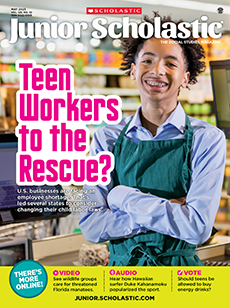Dhaki Wako Baneta knows what it’s like to struggle to survive. The 26-year-old mother of four (right) lives in a rural Ethiopian village where many people lack running water, access to electricity, and economic opportunities. For years, she’d wake up at 6 in the morning, milk her cows, and walk two hours along dusty roads to town to try to sell the milk. Most days, she’d spend hours in the scorching heat without making a single sale.
But Baneta’s life has recently started to improve. A few years ago, the U.S. Agency for International Development (USAID) introduced her to a store owner in town who agreed to buy her milk (as well as milk that Baneta collects from her neighbors) on a daily basis. Now she has a regular customer—and a steady income. She no longer worries about being unable to feed her children or pay for medicine, and she can spend more time with her family.
Baneta plans to eventually use her savings to open a small store in town that sells sugar, oil, and salt. And she wants to teach other women how to start businesses of their own.
“My life is changing,” she says. “I am a focal person in my community.”
Stories like Baneta’s have become increasingly common in recent years. Worldwide, more people are pulling themselves out of extreme poverty than ever before. (Extreme poverty is defined as living on less than $1.90 a day—often without basic necessities like food, clothing, and shelter.) According to the World Bank, the number of people living in extreme poverty has dropped by more than half in the past 25 years. In 1990, an estimated 1.9 billion people lived in extreme poverty. Today, about 700 million do.
Dhaki Wako Baneta knows what it is like to struggle to survive. The 26-year-old mother of four (right) lives in a rural Ethiopian village. Many people there lack running water, access to electricity, and economic opportunities. For years, she woke up at 6 in the morning and milked her cows. Then she walked two hours along dusty roads to town to try to sell the milk. Most days, she spent hours in the scorching heat without making a single sale.
But Baneta’s life has recently started to improve. A few years ago, the U.S. Agency for International Development (USAID) introduced her to a store owner in town. He agreed to buy her milk, plus milk that Baneta collects from her neighbors, on a daily basis. Now she has a regular customer and a steady income. She no longer worries about being unable to feed her children or pay for medicine. She can also spend more time with her family.
Baneta plans to eventually use her savings to open a small store in town. She hopes to sell sugar, oil, and salt. She also wants to teach other women how to start businesses of their own.
“My life is changing,” she says. “I am a focal person in my community.”
Stories like Baneta’s have become increasingly common in recent years. Worldwide, more people are pulling themselves out of extreme poverty than ever before. (Extreme poverty is defined as living on less than $1.90 a day. Often, that is without basic necessities like food, clothing, and shelter.) According to the World Bank, the number of people living in extreme poverty has dropped by more than half in the past 25 years. In 1990, an estimated 1.9 billion people lived in extreme poverty. Today, about 700 million do.
